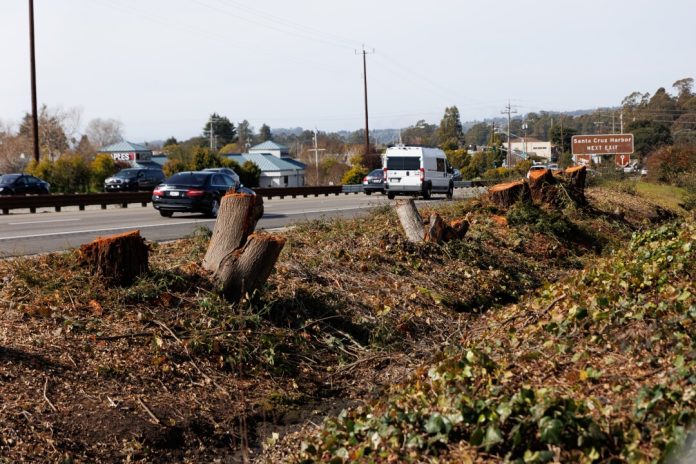have something to say? Lookout welcomes letters to the editor within our policy. guidelines here.
Highway 1 commuters can expect some changes to the busy road soon, and have probably already noticed that crews have cut down a large number of trees.
The project, led by the Santa Cruz County Regional Transportation Commission, includes new auxiliary lanes — lanes that connect freeway on- and off-ramps and allow vehicles more room to merge — between the 41st Avenue and Soquel Drive intersections, the busiest stretch of Highway 1 in the city United States District. Some of these auxiliary lanes will also serve as “bus-on-shoulder lanes,” allowing buses to use the auxiliary lanes to avoid traffic.
The change will not just focus on highway operations. A bicycle/pedestrian overpass beginning at Chanticleer Avenue will cross Highway 1 and provide an alternate route for cyclists and pedestrians currently using the Soquel Drive or 41st Avenue overpass. RTC spokeswoman Shannon Munz said construction was scheduled to start in April as it was delayed from its original start time in late January due to the storm surge.
Munz told Lookout that the project would take about a year to complete, meaning Highway 1 regulars should expect some traffic disruption. What exactly these delays could look like becomes clearer as the groundbreaking gets closer, said Munz.
Munz said the tree removal north of 41st Avenue was inevitable because the area is needed for development. The RTC will replant nearly 500 trees, some around the project corridor and more than 400 in Anna Jean Cummings County Park in Soquel. “I know this is one of those things that people don’t like to see,” Munz said, “so when trees are being cut down for projects like this, we have to put things right.”
(Kevin Painchaud / Santa Cruz Viewpoint)
However, some are skeptical about the purported benefits of working on Highway 1.
Rick Longinotti, chair of the Sustainable Transportation Campaign, said he believes the proposed auxiliary lanes would do little to relieve traffic on Highway 1. He points to the concept of “induced travel,” which argues that expanding roads due to heavy traffic only encourages more traffic, leading to comparable congestion.
“It would be a lot of roadworks on the highway, and according to the environmental impact report, it won’t reduce congestion,” he said. “But they will say we still have to build an auxiliary track. You will have a reason.”
The 2019 Certified Environmental Impact Report from Caltrans and the Federal Highway Administration found that the auxiliary lanes slightly degrade southbound traffic during evening rush hour but improve northbound traffic during morning rush hour and the bottleneck between Soquel Drive and 41st Avenue would eliminate . It was also noted that lower traffic segments would see little to no improvement.
“Our most optimistic goal would be for them to do that next help lane and find out that it didn’t actually help,” Longinotti said.

A representation of the zoning plan at Highway 1 and 41st Avenue. The green marks the suggested auxiliary tracks and the orange marks the start and end of the bus-on-shoulder sections.
(via CDM Smith)
He also criticizes the proposed bus-on-shoulder developments. Despite their name, he said, they only allow bus lanes in short stretches near on and off ramps along Highway 1. Longinotti said there are no bus-on-shoulder lanes defined in this way in the country . He argues that buses will get stuck in traffic at peak times if they can only use auxiliary lanes, and supports the idea of dedicated bus lanes instead.
“It’s more sustainable and it’s a bus project, so I’m sure they would have no problem getting the OK to spend the money that way,” he said.
Munz said any component will not fix the current traffic situation. But that’s why non-highway projects such as the pedestrian/bike overpass are being further developed to get more people off the freeways overall, which Longinotti endorses. “There is not just one solution for all traffic situations that we have, but when we work on multimodal solutions, everyone can work together to defuse them,” said Munz.

A depiction of the bicycle/footbridge designed to cross Highway 1 from Chanticleer Avenue.
(From the Santa Cruz County Regional Transportation Commission)
Munz said the RTC is compiling an FAQ and additional information for the public on these concerns, including those raised by the Sustainable Transport Campaign. She hopes to have them ready within the next week. “There’s a lot of misinformation out there about what this project is and what it will or won’t do,” she said.
Andy Schiffrin, former City of Santa Cruz planning commissioner, said that all publicly funded projects require a balance between competing visions for the county’s transportation system. He explained that Measure D of 2016 – a sales tax that is a direct source of funding for transport projects – signals a compromise between the various projects local authorities want to undertake.
This one, partially funded by Measure D, is no exception. “I may not be enthusiastic about some of these freeway projects,” Schiffrin said, “but I support the compromise.”
Many supporters for these projects are based in South County because residents who commute north from there have to use Highway 1 every day, he said. “From their perspective, even a small improvement makes a big difference.”
Meanwhile, Schiffrin said, those like him who live in the city of Santa Cruz may have a different perspective, as they may not have to travel long distances on the freeway every day during rush hour.
lookout.co
https://lookout.co/santacruz/civic-life/development/story/2023-02-09/highway-1-bus-on-shoulder-auxiliary-lanes-pedestrian-overcrossing-santa-cruz-county-regional-transportation-commission












